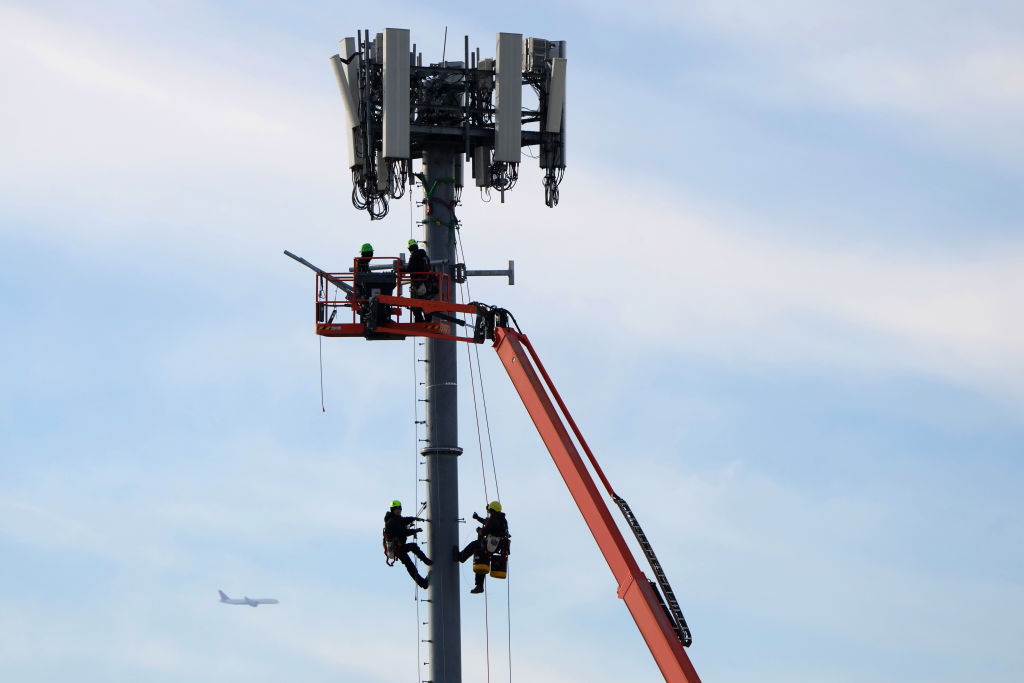It’s strange to have bad cell phone service in a place like Manhattan, a place that is packed with cell towers and technology and that is about as far from a rural, mountainous area as you can get. But I struggle to get a signal in my office in the middle of the city, and beyond—my phone calls at my house in Beacon, NY, frequently turn garbled and disconnect; I often can’t access data while a passenger in a car traveling around the suburbs of New York City, one of the most densely populated regions in the country; and trying to talk to my parents on their cellphones at their home in suburban Boston is like a version of the ‘Can you hear me now?’ commercials, except you replace the actors with Boomers and the answer is always ‘No.”
I’m not the only one with complaints: on average, between April and June of 2023, U.S. cellphone users reported that out of every 100 times they tried to use data, text, or make a call, they had problems 11 times. That’s up from about nine problems per 100 connections in most of 2020 and 2021, according to a report from J.D. Power. All three major carriers—Verizon, T-Mobile, and AT&T had worse scores on this metric in the first part of 2023 than they’d had in early 2021.
“It’s gotten a little bit worse—there’s a problem more than there used to be,” says Carl Lepper, a senior director at J.D. Power. “The industry should be in the 8-9 range, My ears perk up when it gets above 10.”
When I did tests both at my office and at my house on my iPhone 14, the diagnosis was not good. When I turned off my Wi-Fi and relied solely on the cellphone network, speed tests on OpenSignal showed I could upload just 0.1 Mbps at the office and could not download anything, both numbers showing the Internet was practically unusable. A separate test to check my cell phone signal strength found that at home, I had something called RSRP of -108 – generally considered “poor signal,” and at the office, I had RSRP of -111, considered “very poor signal.”
There’s no shortage of news stories in the past year about local areas complaining about a sudden uptick in dropped calls and spotty service. So what’s going on? Why, as we march forward into the future, half a century after the first mobile telephone call was made, do we still struggle so much with phone reception?
More From TIME
I tried to find out.
How cell phones actually work
Cell phones use electromagnetic radio waves to send signals from their antenna to an antenna on a relay tower. These waves aren’t all that different from those that carry music to your car radio—they are even measured on the same frequency, called megahertz. The FM radio spectrum goes from 88 to 108 megahertz (MHz)—cell phones use frequencies between 600 MHz and 40 Gigahertz (or 40,000 MHz).
The higher the frequency, the faster a signal can travel—but these high frequency signals don’t go as long a distance and have a harder time penetrating physical barriers like windows, walls, and trees. The lower the frequency, the easier a signal can travel—AM radio tops out at about 1.6 megahertz, for example, and you can keep the same AM station on the radio as you travel extremely far from the radio tower.
The other important thing to know about the electromagnetic spectrum is that there’s only a certain amount of space available on each level of the spectrum, and there is less space available on the low and middle end of the spectrum than on the high. Low- and mid-band spectrum are very crowded because that’s what has been available, and as more people get cellphones and use more and more data, those lower spectrums have gotten clogged. “There’s nothing really available in the dial anymore in the attractive parts of the spectrum,” says Craig Moffett, a telecom analyst and senior managing director at Moffett Nathanson, a boutique research firm. Meanwhile, more and more people are watching streaming video and joining Zoom calls and making phone calls and sending texts. AT&T, for instance, said in September that total usage on its network is growing 30% per year. “Never in the history of our network have we seen so much traffic,” Chris Sambar, president of AT&T Network, said in a September blog post.
This problem of crowding is exacerbated in places that have seen rapid population growth in recent years—places like the city of Beacon, N.Y., where I live. As more people move to exurbs and suburbs and use more data-intensive services, the competition for that limited spectrum is growing. To provide faster and better service, wireless companies need to build more towers so people can connect to higher spectrums, but cities and towns usually oppose the construction of more towers. There’s currently a Change.org petition in my city of Beacon, NY, for instance, to stop the construction of a 125 foot Verizon cell tower in a local cemetery.
Why Verizon customers may be having more trouble
There’s a reason that I, as a Verizon customer, may be having more problems than my colleagues who use AT&T and T-Mobile, analysts say. It has to do with how much spectrum is available to each carrier.
Verizon had, for some time, decided that buying more spectrum was too expensive, says Entner, the analyst. What’s more, Verizon focused what investment it did make on the ultra high-frequency spectrum—sometimes called “the millimeter wave spectrum”—which is very fast but does not go very far or penetrate buildings or walls. This spectrum was available because most people thought it was too cost-prohibitive to put up enough towers to relay these types of waves far enough to make them valuable.
There are good uses for the millimeter wave spectrum—stadiums, for example, where you can put up lots of towers around the edge so everyone inside will have fast service on high frequency spectrum. But Verizon was focusing so much on the millimeter wave that it didn’t invest enough in low and mid-band spectrum, Moffett says.
By the time it became clear that the company had overcommitted to millimeter wave, he says, they had a huge deficit on mid-band spectrum. That’s why, in March 2021, Verizon spent a whopping $52.9 billion to buy mid-band spectrum called C-Band. But, the company is only using that new spectrum for its 5G ultra wideband network, which costs about $10 more per month. That means it is unaccessible to people like me who don't want to pay even more on my phone bill.

Of course, I can still access other spectrums in Verizon’s network, but I am competing against all the other people trying to do that as well. Analysts I talked to say that T-Mobile has the most low and mid-band spectrum—which may be why OpenSignal, the crowd-sourced mobile measurement app, in July rated T-Mobile as having the best upload and download speeds, as well as the most consistent quality mobile experience. (A separate OpenSignal report gave Verizon top marks for 5G video experience and upload speed, though T-Mobile had the best 5G availability.)
Though a Verizon spokesman enlisted the company's engineers to look at my cell service and tried to trouble-shoot, even saying the company would send more engineers to my office building to figure out what was going on, the company didn’t want to speak on the record about the issues. Instead, it sent a statement saying that Verizon engineers work everyday to provide the most reliable wireless experience for customers, and that it is in the middle of one of the fastest and biggest upgrades in the company’s history. “Our network is consistently rated the best in the industry for network quality by our customers,” including through the J.D. Power surveys, a company spokesman said, in a statement.
Analysts agreed that whenever carriers roll out a new technology like 5G, they have to do a lot of fine-tuning of their networks, which can lead to some temporary problems.
They have to adjust signals and strength so that their radio waves reach far enough without interfering with other waves. “It’s a three-dimensional chess game they have to play, and it’s not easy,” says Entner.
What you can do about bad cell phone reception
You’d think, by 2023, there would be lots of new technology that could improve reception despite the crowding of the radio waves. The problem though is that we have done just about all we can to optimize the spectrums that are available. There are technologies that allow cellphones to use the spectrum more efficiently, but they’re not effective enough to handle the giant increase in data usage that networks are experiencing right now. The amount of traffic each device puts out over the network doubles every two years or so, and there’s no real way to expand capacity that quickly, says Moffett.
There are a few things that you can do if you have the same problems that I do—dropped calls, slow data, frustrating service. If you’re on the edge of a cell network, or if signals can’t penetrate the building you’re in, the best solution is to rely more on Wi-Fi. That helps avoid competing with all the people also using the wireless network, and also means you don’t have to worry about signals penetrating the walls or windows of my building.
Sometimes, however, it’s not as easy as just turning on your Wi-Fi. Though I have Verizon Fios at my house, I was having a lot of trouble getting on Zoom calls and using the Internet. Then a neighbor recommended we get rid of the default Wi-Fi router that Verizon gave us when they installed our service, and replace it with what’s called a mesh network. We bought a (used) router and two satellites from a company called Orbi, hooked them up, and immediately had much faster Wi-Fi in the house.
It’s a solution, for now, and one that gets me off the increasingly crowded wireless network. But there are still times when I leave my house and can’t rely on Wi-Fi. The best solution for that is likely to hope that Verizon and other carriers build more towers near me. They might be ugly, but in an era where we can’t live without good reception on our phones, they may be better than the alternative: bad service and no way to improve it as the amount of data we consume keeps growing every year.
More Must-Reads from TIME
- Cybersecurity Experts Are Sounding the Alarm on DOGE
- Meet the 2025 Women of the Year
- The Harsh Truth About Disability Inclusion
- Why Do More Young Adults Have Cancer?
- Colman Domingo Leads With Radical Love
- How to Get Better at Doing Things Alone
- Michelle Zauner Stares Down the Darkness
Contact us at letters@time.com
